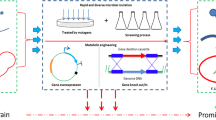Abstract
The phenolic compounds present in hydrolysates pose significant challenges for the sustainable lignocellulosic materials refining industry. Three Saccharomyces cerevisiae strains with high tolerance to lignocellulose hydrolysate were obtained through ethyl methanesulfonate mutation and adaptive evolution. Among them, strain EMV-8 exhibits specific tolerance to vanillin, a phenolic compound common in lignocellulose hydrolysate. The EMV-8 maintains a specific growth rate of 0.104 h−1 in 2 g L−1 vanillin, whereas the reference strain cannot grow. Physiological studies revealed that the vanillin reduction rate of EMV-8 is 1.92-fold higher than its parent strain, and the Trolox equivalent antioxidant capacity of EMV-8 is 15 % higher than its parent strain. Transcriptional analysis results confirmed an up-regulated oxidoreductase activity and antioxidant activity in this strain. Our results suggest that enhancing the antioxidant capacity and oxidoreductase activity could be a strategy to engineer S. cerevisiae for improved vanillin tolerance.




Similar content being viewed by others
References
Allen SA, Clark W, McCaffery JM, Cai Z, Lanctot A, Slininger PJ, Liu ZL, Gorsich SW (2010) Furfural induces reactive oxygen species accumulation and cellular damage in Saccharomyces cerevisiae. Biotechnol Biofuels 3:2. doi:10.1186/1754-6834-3-2
Ding MZ, Wang X, Yang Y, Yuan YJ (2011) Metabolomic study of interactive effects of phenol, furfural, and acetic acid on Saccharomyces cerevisiae. OMICS 15(10):647–653. doi:10.1089/omi.2011.0003
Endo A, Nakamura T, Ando A, Tokuyasu K, Shima J (2008) Genome-wide screening of the genes required for tolerance to vanillin, which is a potential inhibitor of bioethanol fermentation, in Saccharomyces cerevisiae. Biotechnol Biofuels 1(1):3. doi:10.1186/1754-6834-1-3
Endo A, Nakamura T, Shima J (2009) Involvement of ergosterol in tolerance to vanillin, a potential inhibitor of bioethanol fermentation, in Saccharomyces cerevisiae. FEMS Microbiol Lett 299(1):95–99. doi:10.1111/j.1574-6968.2009.01733.x
Fitzgerald DJ, Stratford M, Narbad A (2003) Analysis of the inhibition of food spoilage yeasts by vanillin. Int J Food Microbiol 86(1–2):113–122
Gorsich SW, Dien BS, Nichols NN, Slininger PJ, Liu ZL, Skory CD (2006) Tolerance to furfural-induced stress is associated with pentose phosphate pathway genes ZWF1, GND1, RPE1, and TKL1 in Saccharomyces cerevisiae. Appl Microbiol Biotechnol 71(3):339–349. doi:10.1007/s00253-005-0142-3
Ji L, Shen Y, Xu L, Peng B, Xiao Y, Bao X (2011) Enhanced resistance of Saccharomyces cerevisiae to vanillin by expression of lacA from Trametes sp. AH28-2. Bioresour Technol 102(17):8105–8109. doi:10.1016/j.biortech.2011.06.057
Jonsson LJ, Alriksson B, Nilvebrant NO (2013) Bioconversion of lignocellulose: inhibitors and detoxification. Biotechnol Biofuels 6(1):16. doi:10.1186/1754-6834-6-16
Li BZ, Yuan YJ (2010) Transcriptome shifts in response to furfural and acetic acid in Saccharomyces cerevisiae. Appl Microbiol Biotechnol 86(6):1915–1924. doi:10.1007/s00253-010-2518-2
Liu ZL (2006) Genomic adaptation of ethanologenic yeast to biomass conversion inhibitors. Appl Microbiol Biotechnol 73(1):27–36. doi:10.1007/s00253-006-0567-3
Liu ZL, Ma M, Song M (2009) Evolutionarily engineered ethanologenic yeast detoxifies lignocellulosic biomass conversion inhibitors by reprogrammed pathways. Mol Genet Genomics 282(3):233–244. doi:10.1007/s00438-009-0461-7
Luo JG, Li L, Kong LY (2012) Preparative separation of phenylpropenoid glycerides from the bulbs of Lilium lancifolium by high-speed counter-current chromatography and evaluation of their antioxidant activities. Food Chem 131(3):1056–1062
Ma M, Liu ZL (2010) Comparative transcriptome profiling analyses during the lag phase uncover YAP1, PDR1, PDR3, RPN4, and HSF1 as key regulatory genes in genomic adaptation to the lignocellulose derived inhibitor HMF for Saccharomyces cerevisiae. BMC Genomic 11:660. doi:10.1186/1471-2164-11-660
Mira NP, Palma M, Guerreiro JF, Sa-Correia I (2010) Genome-wide identification of Saccharomyces cerevisiae genes required for tolerance to acetic acid. Microb Cell Fact 9:79. doi:10.1186/1475-2859-9-79
Mollapour M, Piper PW (2007) Hog1 mitogen-activated protein kinase phosphorylation targets the yeast Fps1 aquaglyceroporin for endocytosis, thereby rendering cells resistant to acetic acid. Mol Cell Biol 27(18):6446–6456. doi:10.1128/MCB.02205-06
Mollapour M, Shepherd A, Piper PW (2008) Novel stress responses facilitate Saccharomyces cerevisiae growth in the presence of the monocarboxylate preservatives. Yeast 25(3):169–177. doi:10.1002/yea.1576
Nguyen TT, Iwaki A, Ohya Y, Izawa S (2013) Vanillin causes the activation of Yap1 and mitochondrial fragmentation in Saccharomyces cerevisiae. J Biosci Bioeng. doi:10.1016/j.jbiosc.2013.06.008
Palmqvist E, Hahn-Hägerdal B (2000) Fermentation of lignocellulosic hydrolysates. I: inhibition and detoxification. Bioresour Technol 74(1):17–24
Palmqvist E, Hahn-Hägerdal B (2000) Fermentation of lignocellulosic hydrolysates. II: inhibitors and mechanisms of inhibition. Bioresour Technol 74(1):25–33
Park SE, Koo HM, Park YK, Park SM, Park JC, Lee OK, Park YC, Seo JH (2011) Expression of aldehyde dehydrogenase 6 reduces inhibitory effect of furan derivatives on cell growth and ethanol production in Saccharomyces cerevisiae. Bioresour Technol 102(10):6033–6038. doi:10.1016/j.biortech.2011.02.101
Pereira FB, Guimaraes PM, Gomes DG, Mira NP, Teixeira MC, Sa-Correia I, Domingues L (2011) Identification of candidate genes for yeast engineering to improve bioethanol production in very high gravity and lignocellulosic biomass industrial fermentations. Biotechnol Biofuels 4(1):57. doi:10.1186/1754-6834-4-57
Shen Y, Chen X, Peng B, Chen L, Hou J, Bao X (2012) An efficient xylose-fermenting recombinant Saccharomyces cerevisiae strain obtained through adaptive evolution and its global transcription profile. Appl Microbiol Biotechnol 96(4):1079–1091. doi:10.1007/s00253-012-4418-0
Yang J, Ding MZ, Li BZ, Liu ZL, Wang X, Yuan YJ (2012) Integrated phospholipidomics and transcriptomics analysis of Saccharomyces cerevisiae with enhanced tolerance to a mixture of acetic acid, furfural, and phenol. OMICS 16(7–8):374–386. doi:10.1089/omi.2011.0127
Zhang X, Shen Y, Shi W, Bao X (2010) Ethanolic cofermentation with glucose and xylose by the recombinant industrial strain Saccharomyces cerevisiae NAN-127 and the effect of furfural on xylitol production. Bioresour Technol 101(18):7104–7110
Acknowledgments
This work was supported by the Grants of the National Basic Research Program of China (2011CB707405), the National High Technology Research and Development Program of China (2012AA022106), the National Natural Science Foundation of China (30970091), the State Key Laboratory of Motor Vehicle Biofuel Technology (No. 2013004), and the Independent Innovation Foundation of Shandong University (IIFSDU 2010TS059).
Author information
Authors and Affiliations
Corresponding author
Electronic supplementary material
Below is the link to the electronic supplementary material.
Rights and permissions
About this article
Cite this article
Shen, Y., Li, H., Wang, X. et al. High vanillin tolerance of an evolved Saccharomyces cerevisiae strain owing to its enhanced vanillin reduction and antioxidative capacity. J Ind Microbiol Biotechnol 41, 1637–1645 (2014). https://doi.org/10.1007/s10295-014-1515-3
Received:
Accepted:
Published:
Issue Date:
DOI: https://doi.org/10.1007/s10295-014-1515-3




